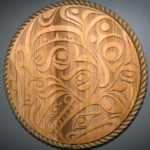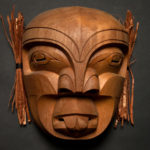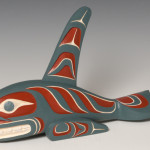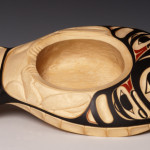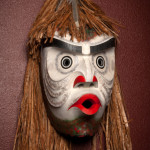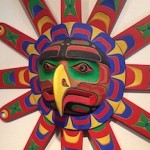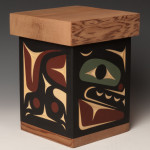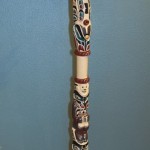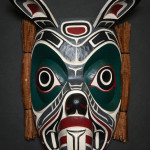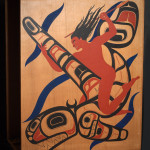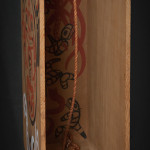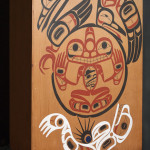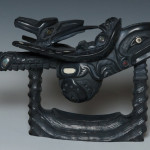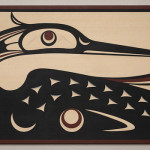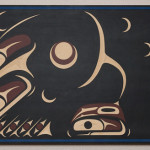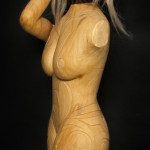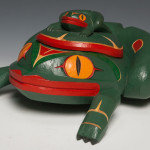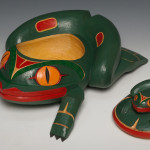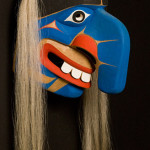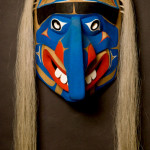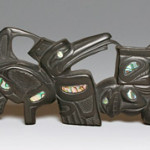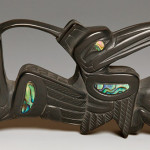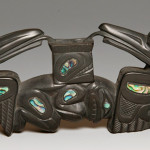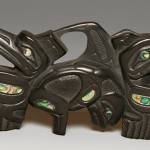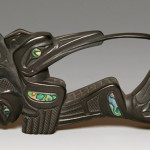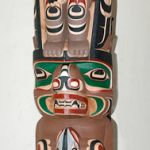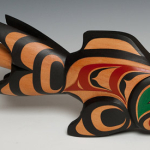Northwest Coast Art
Northwest Coast Native art has always had the power to enthrall viewers. From the first explorers to the present day collector, highly graphic and inventive Indian designs have intrigued and sometimes mystified observers. Distinguished by sophistication and complexity, yet composed of simple traditional elements, Northwest Coast Indian art has become one of the most sought after contemporary art forms.
Although grouped together as “Northwest Coast” the work of the major cultural groups – Haida, Tlingit, Tsimpshian, Kwagiutl and Coast Salish – show many stylistic differences. All Northwest Coast native art, however, makes use of local cedar for masks, monumental art, wood carving, bentwood boxes and baskets. Magnificent totem poles and house posts have become emblematic of the Northwest Coast and tell stories of a rich, ancient native culture.
The same traditional form-line designs used on totem poles and masks are now employed on contemporary two-dimensional art. Serigraphs or silk-screens sold in limited editions have become one of the most popular forms of non-traditional, commercial Northwest Coast Native Indian art.
Coast Salish artist Susan Point’s works in glass, and Kwagiutl artists Richard and Stan Hunt’s bronzes have also stretched the boundaries of materials used by contemporary Northwest Coast tribal artists. As prominent Haida artist Robert Davidson has said: “The only way tradition can be carried on is to keep inventing new things.”
- ” Salmon Panel ” Jason Hunt $3,800
- ” The Watcher Mask ” by Doug David 8″ wide x 14″ high x 5″ deep $1,600
- ” Eagle Panel ” by Trevor Hunt 36″ diameter $3,800
- ” Sun Mask ” by Tom Hunt 6′ 2″ wide x 5′ 6″ high x 12″ deep $6,500
- ” Pugwis ” by Stanley Clifford Hunt 11″ wide x 9″ high x 7″ deep $2,400
- ” Eagle in the Sunlight ” by Trevor Angus 7″ wide x 55″ high $1,600
- ” Orca Rattle ” by Erich Glendale 13″ wide x 9″ high x 4″ deep $1,800
- ” Orca Spirit ” by Heber Reece 11″ wide x 25″ high x 7″ deep $3,600
- ” Of this Land ” by Stanley Clifford Hunt 58″ wide x 23″ high $10,000
- “Halibut Bowl” by Heber Reece 18″ wide x 9″ high $2,800
- ” Spirit of the Drowned” by Greg Colfax 11″ wide x 16″ high x 8″ deep $3,500
- ” Wild Man of the Woods” by Greg Colfax 9″ wide x 12″ high x 9″ deep $3,500
- “Sun Mask” by Richard Hunt 44″ w x 43″h $10,000
- “Orca Box” by Dennis Allen 6″ wide x 9″ high x 6″ deep $600
- “Talking Stick” by Patrick Hunt 22” w x 64”h x 4”d – $8,500
- “Mouse Mask“ by Bert Smith 15” w x 8”h x 8”d – $2,400
- “Box Drum“ by David and Zach Boxley 31” w x 41”h x 13d – $4,800
- Box Drum “ by David and Zach Boxley Alternate view
- “Box Drum “ by David and Zach Boxley Alternate view 2
- “Raven Rattle” by Lionel Samuels 16″w x 8″h x 5″d
- “Loon Panel” by Dennis Allen 33”w x 18”h – $1,800
- “Crane Panel” by Dennis Allen 33”w x 17”h – Sold
- “Beyond the Mask” by Rande Cook 17” wide by 41”high x 13” deep – $25,000
- “Frog Bowl” by Stan Hunt 10″ w x 5″h x 8″d $4,500
- “Frog Bowl” by Stan Hunt Alternate view
- “Fools Mask” by Tony Hunt Jr. 9″w x 15″h x 11″d – $4,000
- “Fools Mask” by Tony Hunt Jr. – alternate view
- “Conspiracy of Ravens” by Lionel Samuels – entire view 18″w x 4″h x 1″d – $20,000
- “Conspiracy of Ravens” by Lionel Samuels – detail view 1
- “Conspiracy of Ravens” by Lionel Samuels – detail view 2
- “Conspiracy of Ravens” by Lionel Samuels – detail view 3
- “Conspiracy of Ravens” by Lionel Samuels – detail view 4
- “Henry’s Pole” by Trevor Hunt 2 feet wide by 10 feet high – (inquire)
- “Salmon Rattle” by Trevor Hunt 20″w x 7″h x 3″d – $2,400

